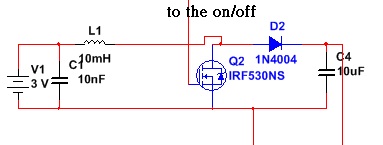I'm currently building a DC-DC step up circuit to step up 3V to 100V. I don't want to use transformer because i want to keep the circuit as small as possible. My thought is ... building a 30V-output circuit using MIC2250, then build a boost circuit to boost the voltage 3-4 times. The 30V output has been achieved, but the boost doesn't work. The diagram is as below.

I was thinking of repeating this circuit 2 to 3 times in order to step up the overall voltage 2-3 times. but it doesn't work.
My another design is to use IC solely. some ICs like LT3757 and LT3783 seem to fit my design, but I just don't find any suggested circuit to boost from 3V to 100V. I tried MCP1652 before by following the circuit in the datasheet. Although the datasheet clams that the circuit can step up the input to 100V, I just can't do it. The maximum I got was only 40V.(I emailed the technician from MCP...he asked me to find the solution on the internet myself...poor aftersale service...) the only suggested circuit from 5V to 350V in LT3757 requires transformer, but i just try to avoid transformer.
Can any body share you idea with me about the circuit stepping up from 3V to 100V? Iout = 0.1A will be good enough. slightly smaller will be acceptable too.
